Quality Perspective on the Dynamic Balance of Cultivated Land in Wenzhou, China
Abstract
:1. Introduction
2. Materials and Methods
2.1. Study Area
2.2. Data Sources
2.3. Methods
2.3.1. Assessment of Cultivated Land Quality
2.3.2. Relative Loss and Gain Rate of Cultivated Land of Different Quality
3. Results
3.1. Quantity Changes of Lost/Gained Cultivated Lands
3.2. Quality Changes of Lost/Gained Cultivated Lands
3.3. Composition of Lost/Gained Cultivated Lands
3.4. Trends of Cultivated Land Changes across Time and Space
3.5. Utilization of Gained Cultivated Land Based on Remote-Sensing Images
4. Discussion
4.1. Characterization of Quality and Quantity for Cultivated Land
4.2. Efficiency of Gained Cultivated Land
4.3. Prediction of Future Cultivated Land Changes
4.4. Policy and Management Implications
5. Conclusions
Acknowledgments
Author Contributions
Conflicts of Interest
References
- Antón, J.; Cattaneo, A.; Kimura, S.; Lankoski, J. Agricultural risk management policies under climate uncertainty. Glob. Environ. Chang. 2013, 23, 1726–1736. [Google Scholar] [CrossRef]
- Liu, Y.S.; Wang, J.Y.; Long, H.L. Analysis of arable land loss and its impact on rural sustainability in Southern Jiangsu Province of China. J. Environ. Manag. 2010, 91, 646–653. [Google Scholar] [CrossRef] [PubMed]
- Su, S.; Zhang, Q.; Zhang, Z.; Zhi, J.; Wu, J. Rural settlement expansion and paddy soil loss across an ex-urbanizing watershed in eastern coastal China during market transition. Reg. Environ. Chang. 2011, 11, 651–662. [Google Scholar] [CrossRef]
- Van vliet, J.; de Groot, H.L.F.; Rietveld, P.; Verburg, P.H. Manifestations and underlying drivers of agricultural land use change in Europe. Landsc. Urban Plan. 2015, 133, 24–36. [Google Scholar] [CrossRef]
- Houghton, R.A.; Hackler, J.L. Sources and sinks of carbon from land-use change in China. Glob. Biogeochem. Cycles 2003, 17, 1–3. [Google Scholar] [CrossRef]
- Tan, M.; Li, X.; Xie, H.; Lu, C. Urban land expansion and arable land loss in China—A case study of Beijing–Tianjin–Hebei region. Land Use Policy 2005, 22, 187–196. [Google Scholar] [CrossRef]
- Albersen, P.; Fischer, G.; Keyzer, M.; Sun, L.; Jernelv, A. Estimation of agricultural production relations in the LUC Model for China. Nucleic Acids Res. 2001, 37, e107. [Google Scholar]
- Ramankutty, N.; Foley, J.A.; Olejniczak, N.J. People on the Land: Changes in Global Population and Croplands during the 20th Century. AMBIO J. Hum. Environ. 2002, 31, 251–257. [Google Scholar] [CrossRef]
- Yang, H.; Li, X. Cultivated land and food supply in China. Land Use Policy 2000, 17, 73–88. [Google Scholar] [CrossRef]
- Ho, S.P.S.; Lin, G.C.S. Converting land to nonagricultural use in China’s coastal provinces: Evidence from Jiangsu. Mod. China 2004, 30, 81–112. [Google Scholar] [CrossRef]
- National Bureau of Statistical of China. China Statistical Yearbook, 1979; China Statistics Press: Beijing, China, 1979. (In Chinese) [Google Scholar]
- National Bureau of Statistical of China. China Statistical Yearbook, 1997; China Statistics Press: Beijing, China, 1997. (In Chinese) [Google Scholar]
- Liu, Y.; Liu, Y.; Jiao, L.; Zhang, Y. Analysis on the dynamic balance between cultivated land supply and demand at multimeasures based on RS data. Proc. SPIE Int. Soc. Opt. Eng. 2004, 5232, 173–183. [Google Scholar]
- Xiao, L.; Yang, X.; Cai, H.; Zhang, D. Cultivated Land Changes and Agricultural Potential Productivity in Mainland China. Sustainability 2015, 7, 11893–11908. [Google Scholar] [CrossRef]
- Imhoff, M.L.; Lawerence, W.T.; Stutzer, D.; Elvidge, C. Assessing the Impact of Urban Sprawl on Soil Resources in the United States Using Nighttime “City Lights” Satellite Images and Digital Soils Maps. Available online: http://biology.usgs.gov/luhna/chap3.html (accessed on 30 December 2016).
- Francis, C.A.; Hansen, T.E.; Fox, A.A.; Hesje, P.J.; Nelson, H.E.; Lawseth, A.E.; English, A. Farmland conversion to non-agricultural uses in the US and Canada: Current impacts and concerns for the future. Int. J. Agric. Sustain. 2012, 10, 8–24. [Google Scholar] [CrossRef]
- Ceccarelli, T.; Bajocco, S.; Perini, L.; Salvati, L. Urbanisation and Land Take of High Quality Agricultural Soils—Exploring Long-term Land Use Changes and Land Capability in Northern Italy. Int. J. Environ. Res. 2013, 8, 181–192. [Google Scholar]
- Del Mar López, T.; Aide, T.M.; Thomlinson, J.R. Urban Expansion and the Loss of Prime Agricultural Lands in Puerto Rico. AMBIO J. Hum. Environ. 2001, 30, 49–54. [Google Scholar] [CrossRef]
- Deng, J.S.; Qiu, L.F.; Wang, K.; Yang, H.; Shi, Y.Y. An integrated analysis of urbanization-triggered cropland loss trajectory and implications for sustainable land management. Cities 2011, 28, 127–137. [Google Scholar] [CrossRef]
- Zhong, T.; Huang, X.; Zhang, X.; Wang, K. Temporal and spatial variability of agricultural land loss in relation to policy and accessibility in a low hilly region of southeast China. Land Use Policy 2011, 28, 762–769. [Google Scholar] [CrossRef]
- Su, S.; Ma, X.; Xiao, R. Agricultural landscape pattern changes in response to urbanization at ecoregional scale. Ecol. Indic. 2014, 40, 10–18. [Google Scholar] [CrossRef]
- Morelli, S.; Segoni, S.; Manzo, G.; Ermini, L.; Catani, F. Urban planning, flood risk and public policy: The case of the Arno River, Firenze, Italy. Appl. Geogr. 2012, 34, 205–218. [Google Scholar] [CrossRef]
- Munroe, D.K.; Croissant, C.; York, A.M. Land use policy and landscape fragmentation in an urbanizing region: Assessing the impact of zoning. Appl. Geogr. 2005, 25, 121–141. [Google Scholar] [CrossRef]
- Thompson, A.W.; Prokopy, L.S. Tracking urban sprawl: Using spatial data to inform farmland preservation policy. Land Use Policy 2009, 26, 194–202. [Google Scholar] [CrossRef]
- Feng, C.; Hongbo, W.; Wenju, Y. Study on Investigation and Assessment of Cultivated Land Quality Grade in China. China Land Sci. 2014, 75, 75–82. [Google Scholar]
- Song, W.; Pijanowski, B.C. The effects of China’s cultivated land balance program on potential land productivity at a national scale. Appl. Geogr. 2014, 46, 158–170. [Google Scholar] [CrossRef]
- Natuhara, Y. Ecosystem services by paddy fields as substitutes of natural wetlands in Japan. Ecol. Eng. 2013, 56, 97–106. [Google Scholar] [CrossRef]
- Walters, S.A.; Groninger, J.W. Water distribution systems and on-farm irrigation practices: Limitations and consequences for Afghanistan’s agricultural productivity. Water Int. 2014, 39, 348–359. [Google Scholar] [CrossRef]
- Linke, J.; Franklin, S.E.; Huettmann, F.; Stenhouse, G.B. Seismic Cutlines, Changing Landscape Metrics and Grizzly Bear Landscape use in Alberta. Landsc. Ecol. 2005, 20, 811–826. [Google Scholar] [CrossRef]
- Su, S.; Zhou, X.; Wan, C.; Li, Y.; Kong, W. Land use changes to cash crop plantations: Crop types, multilevel determinants and policy implications. Land Use Policy 2016, 50, 379–389. [Google Scholar] [CrossRef]
- Zhang, Z.; Su, S.; Xiao, R.; Jiang, D.; Wu, J. Identifying determinants of urban growth from a multi-scale perspective: A case study of the urban agglomeration around Hangzhou Bay, China. Appl. Geogr. 2013, 45, 193–202. [Google Scholar] [CrossRef]
- Huang, D.; Jin, H.; Zhao, X.; Liu, S. Factors Influencing the Conversion of Arable Land to Urban Use and Policy Implications in Beijing, China. Sustainability 2015, 7, 180–194. [Google Scholar] [CrossRef]
- Xiao, R.; Su, S.; Zhang, Z.; Qi, J.; Jiang, D.; Wu, J. Dynamics of soil sealing and soil landscape patterns under rapid urbanization. Catena 2013, 109, 1–12. [Google Scholar] [CrossRef]
- Pan, X.; Zhao, Q. Measurement of urbanization process and the paddy soil loss in Yixing city, China between 1949 and 2000. Catena 2007, 69, 65–73. [Google Scholar] [CrossRef]
- Song, W.; Pijanowski, B.C.; Tayyebi, A. Urban expansion and its consumption of high-quality farmland in Beijing, China. Ecol. Indic. 2015, 54, 60–70. [Google Scholar] [CrossRef]
- Thapa, R.B.; Murayama, Y. Drivers of urban growth in the Kathmandu valley, Nepal: Examining the efficacy of the analytic hierarchy process. Appl. Geogr. 2010, 30, 70–83. [Google Scholar] [CrossRef]
- Zhen, G.; Wu, Y. Basic farmland protection system should be priority in dynamic balance system of total arable land. J. Hunan Financ. Econ. Univ. 2016, 32, 54–62. [Google Scholar]
- Alexakis, D.; Gotsis, D.; Giakoumakis, S. Evaluation of soil salinization in a Mediterranean site (Agoulinitsa district—West Greece). Arab. J. Geosci. 2015, 8, 1373–1383. [Google Scholar] [CrossRef]
- Lichtenberg, E.; Ding, C. Assessing farmland protection policy in China. Land Use Policy 2008, 25, 59–68. [Google Scholar] [CrossRef]
- Su, S.; Xiao, R. Spatially Varying Determinants of Farmland Conversion across Qiantang Watershed, China. Environ. Manag. 2013, 52, 907–916. [Google Scholar] [CrossRef] [PubMed]
- Cardille, J. Agricultural land-use change in Brazilian Amazônia between 1980 and 1995: Evidence from integrated satellite and census data. Remote Sens. Environ. 2003, 87, 551–562. [Google Scholar] [CrossRef]
- Su, S.; Xiao, R.; Zhang, Y. Multi-scale analysis of spatially varying relationships between agricultural landscape patterns and urbanization using geographically weighted regression. Appl. Geogr. 2012, 32, 360–375. [Google Scholar] [CrossRef]
- Sonobe, T.; Hu, D.; Otsuka, K. From inferior to superior products: An inquiry into the Wenzhou model of industrial development in China. J. Comp. Econ. 2004, 32, 542–563. [Google Scholar] [CrossRef] [Green Version]
- Wenzhou Municipal People’s Government. In 13th Five-Year Plan for Economic and Social Development of Wenzhou City. Available online: http://www.wenzhou.gov.cn/art/2016/3/22/art_1217830_1520814.html (accessed on 15 November 2016).
- Wang, J.; Chen, Y.; Shao, X.; Zhang, Y.; Cao, Y. Land-use changes and policy dimension driving forces in China: Present, trend and future. Land Use Policy 2012, 29, 737–749. [Google Scholar] [CrossRef]
- Su, S.; Li, D.; Hu, Y.N.; Xiao, R.; Zhang, Y. Spatially non-stationary response of ecosystem service value changes to urbanization in Shanghai, China. Ecol. Indic. 2014, 45, 332–339. [Google Scholar] [CrossRef]
- Hofmann, N.; Filoso, G.; Schofield, M.; Statistics, Canada. The loss of dependable agricultural land in Canada. Rural Small Town Can. Anal. Bull. 2005, 6, 1–16. [Google Scholar]
- Liu, Y.; Fang, F.; Li, Y. Key issues of land use in China and implications for policy making. Land Use Policy 2014, 40, 6–12. [Google Scholar] [CrossRef]
- Zhong, T.; Mitchell, B.; Huang, X. Success or failure: Evaluating the implementation of China’s National General Land Use Plan (1997–2010). Habitat Int. 2014, 44, 93–101. [Google Scholar] [CrossRef]
- Song, J.; Cai, D.; Deng, J.; Wang, K.; Shen, Z. Dynamics of Paddy Field Patterns in Response to Urbanization: A Case Study of the Hang-Jia-Hu Plain. Sustainability 2015, 7, 13813–13835. [Google Scholar] [CrossRef]
- Su, S.; Hu, Y.N.; Luo, F.; Mai, G.; Wang, Y. Farmland fragmentation due to anthropogenic activity in rapidly developing region. Agric. Syst. 2014, 131, 87–93. [Google Scholar] [CrossRef]
- Lichtenberg, E.; Ding, C. Local officials as land developers: Urban spatial expansion in China. J. Urban Econ. 2009, 66, 57–64. [Google Scholar] [CrossRef]
- Gosnell, H.; Kline, J.D.; Chrostek, G.; Duncan, J. Is Oregon’s land use planning program conserving forest and farm land? A review of the evidence. Land Use Policy 2011, 28, 185–192. [Google Scholar] [CrossRef]
- Kline, J.D.; Thiers, P.; Ozawa, C.P.; Yeakley, A.J.; Gordon, S.N. How well has land-use planning worked under different governance regimes? A case study in the Portland, OR-Vancouver, WA metropolitan area, USA. Landsc. Urban Plan. 2014, 131, 51–63. [Google Scholar] [CrossRef]
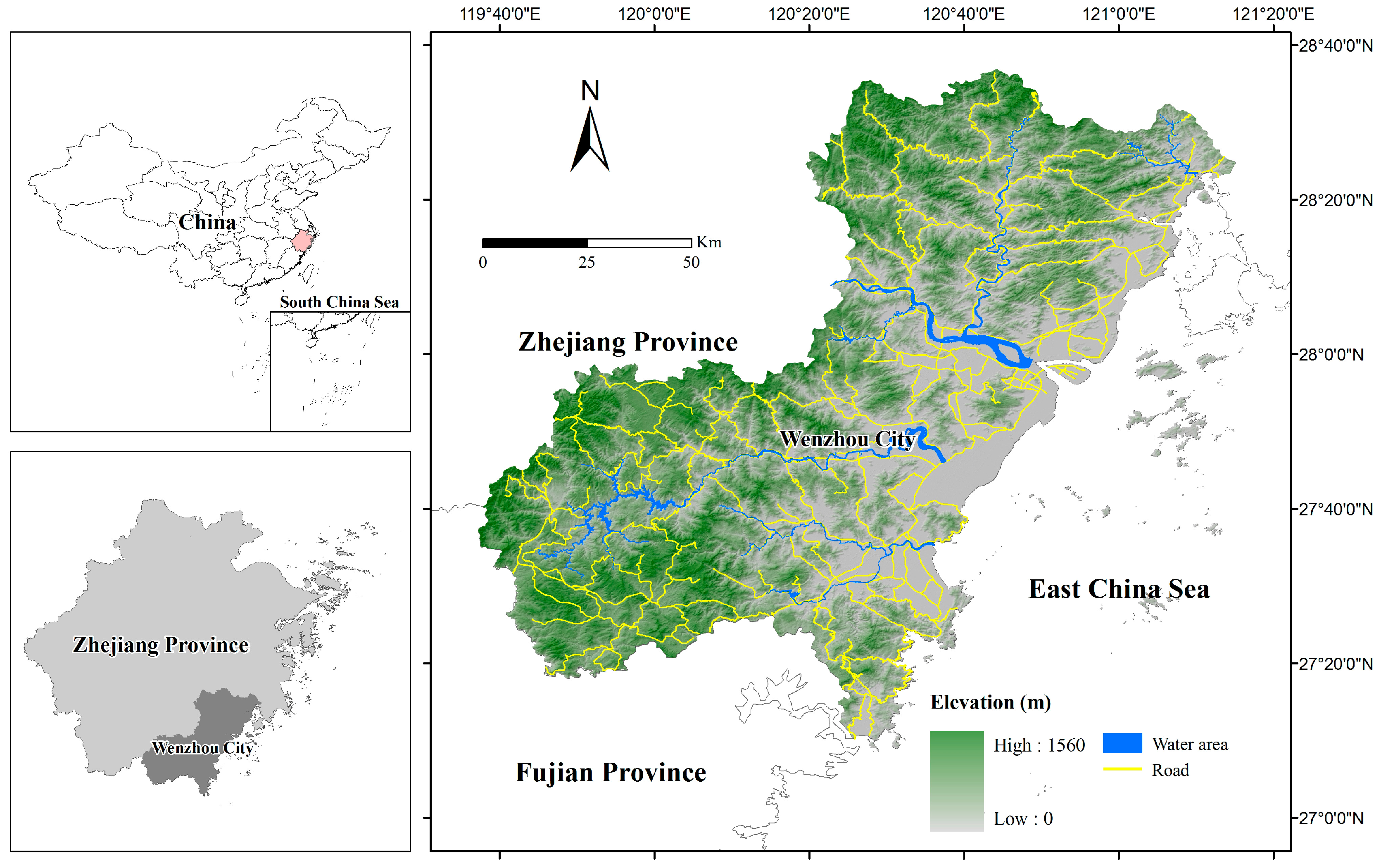

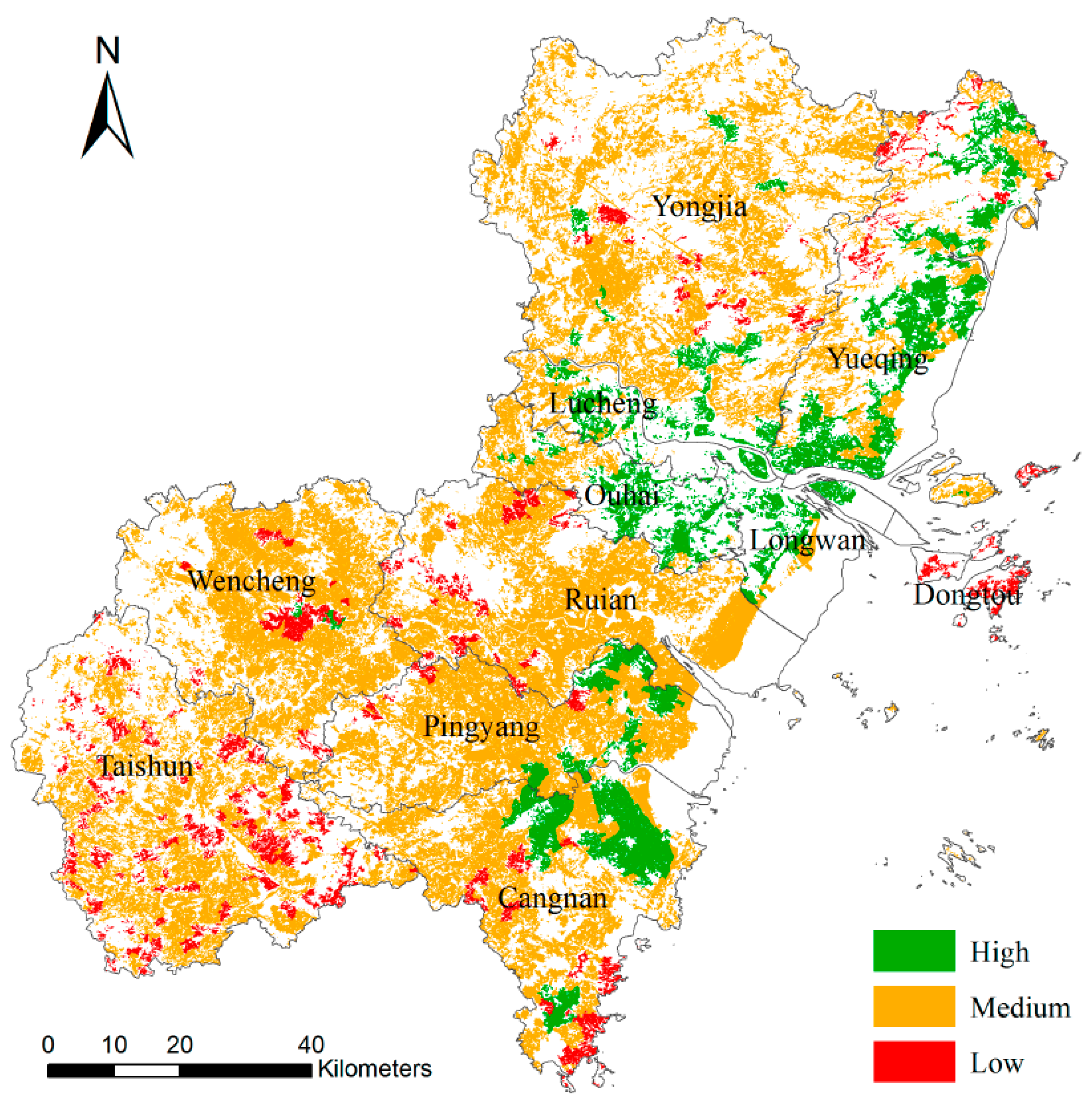
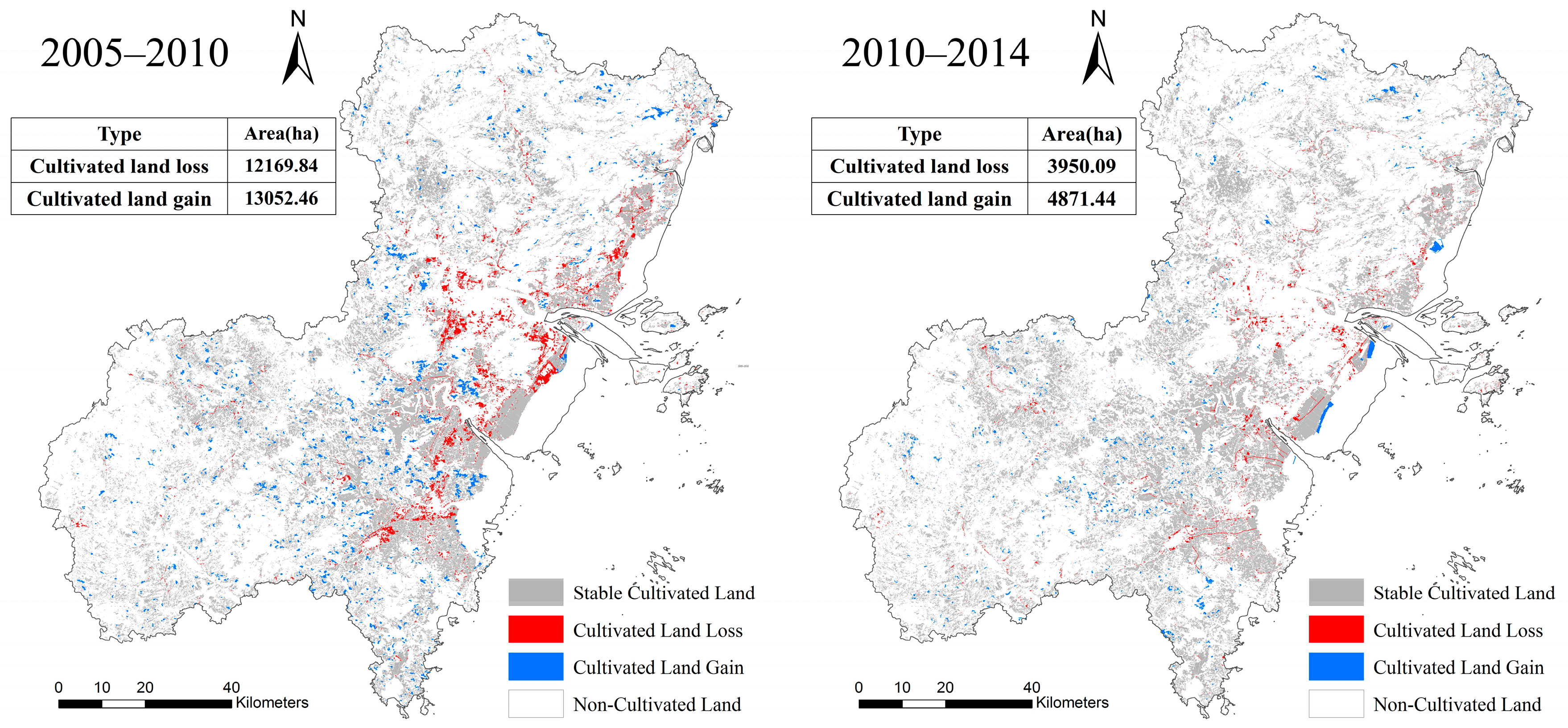
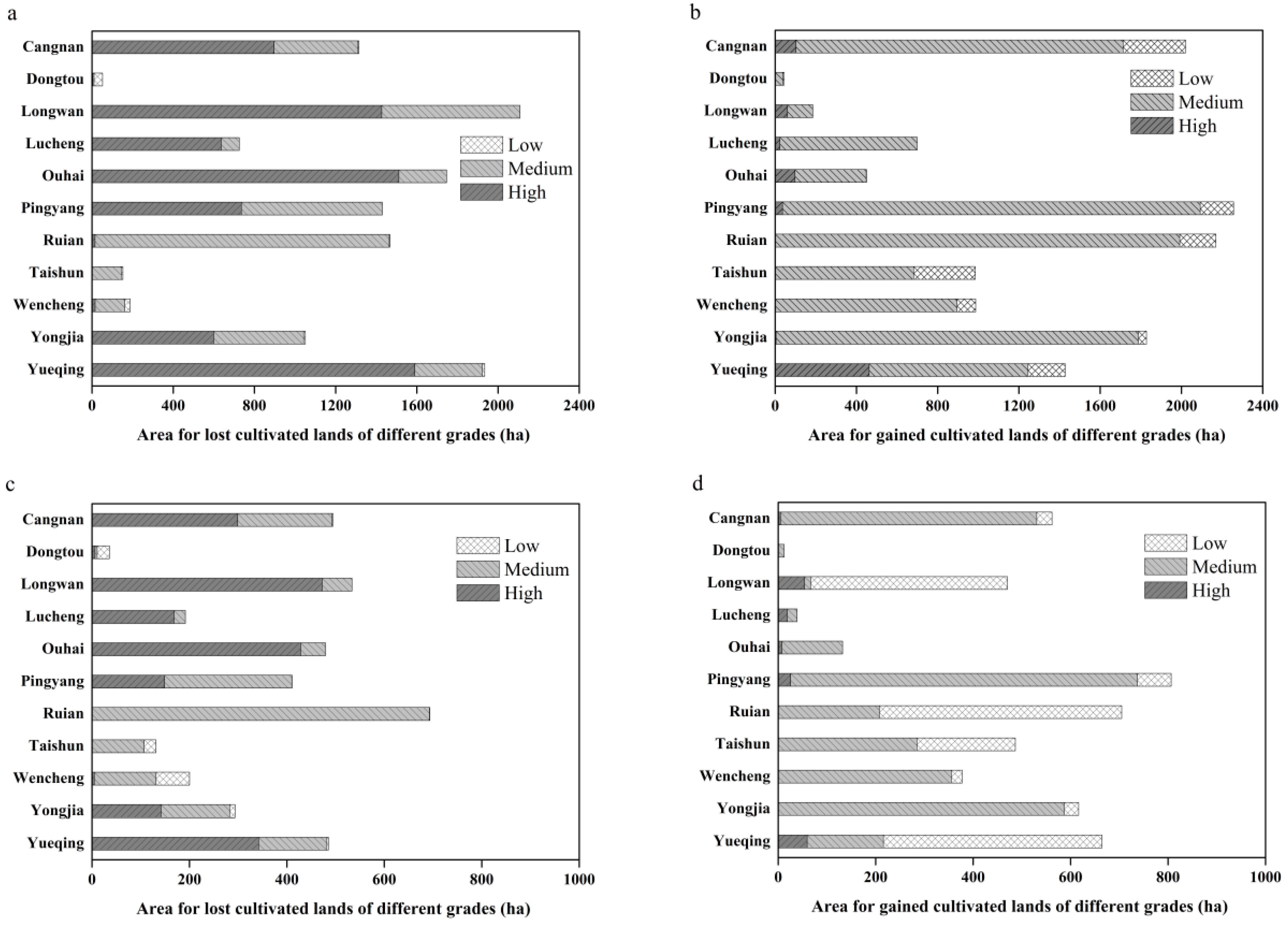

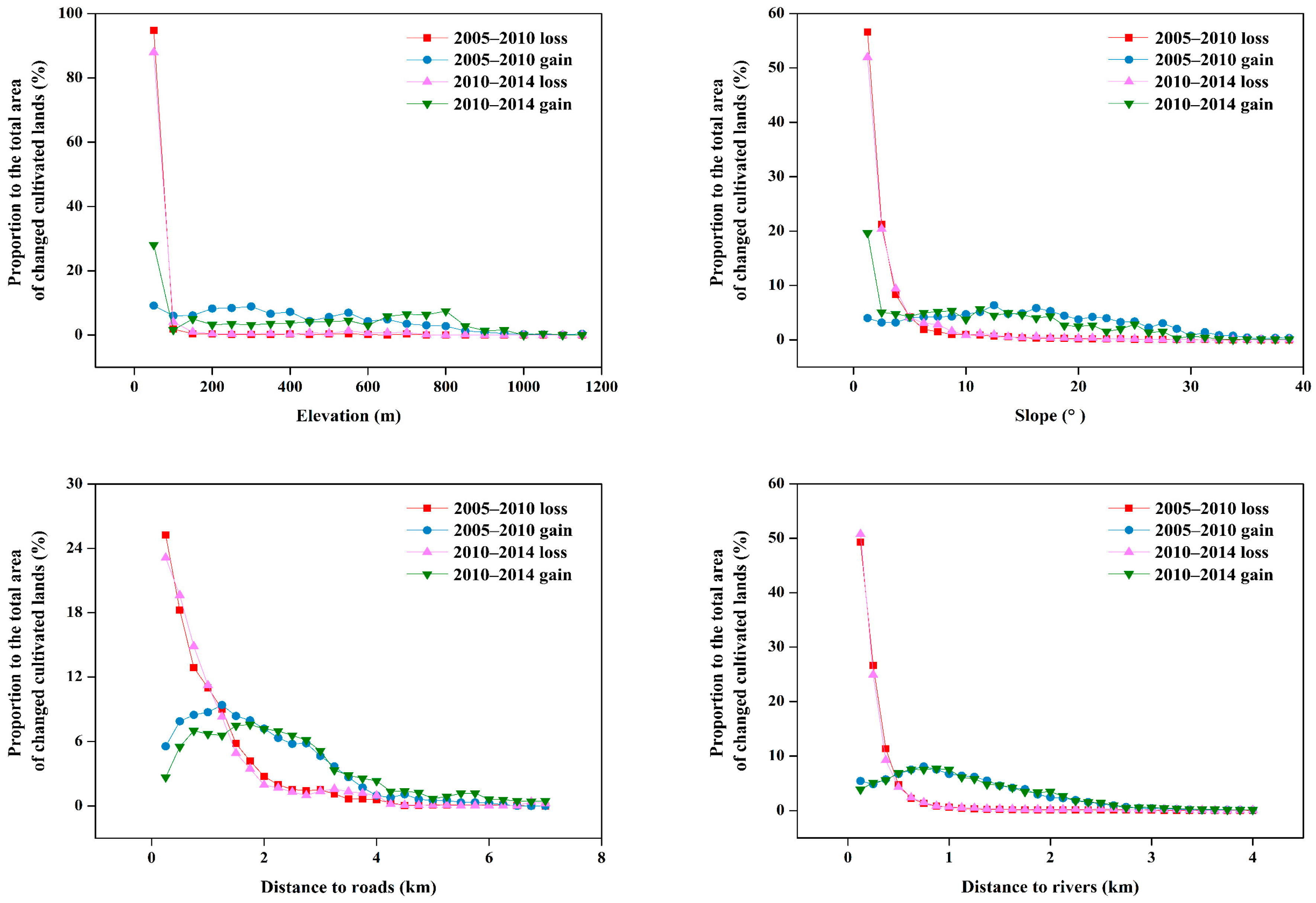
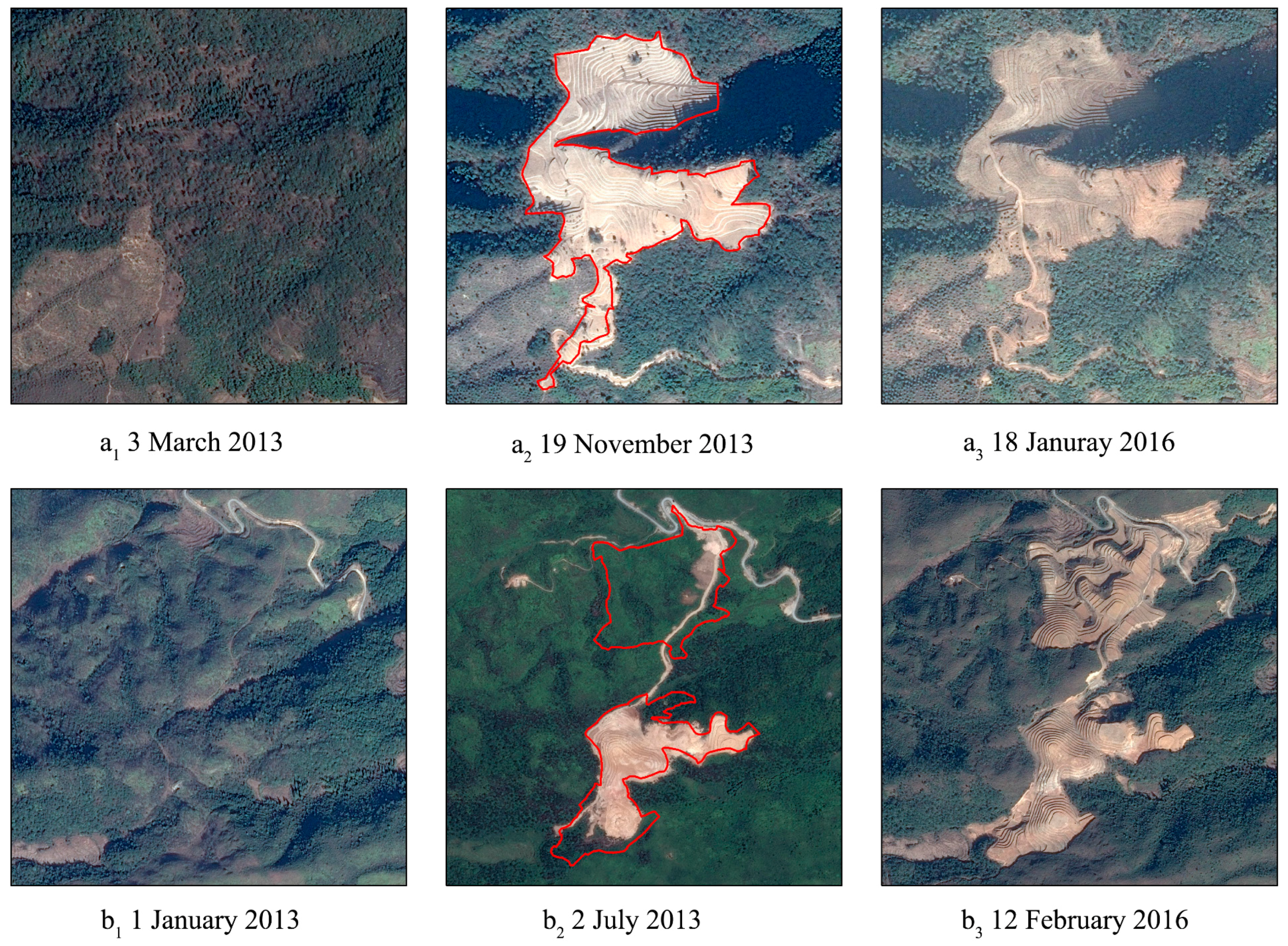
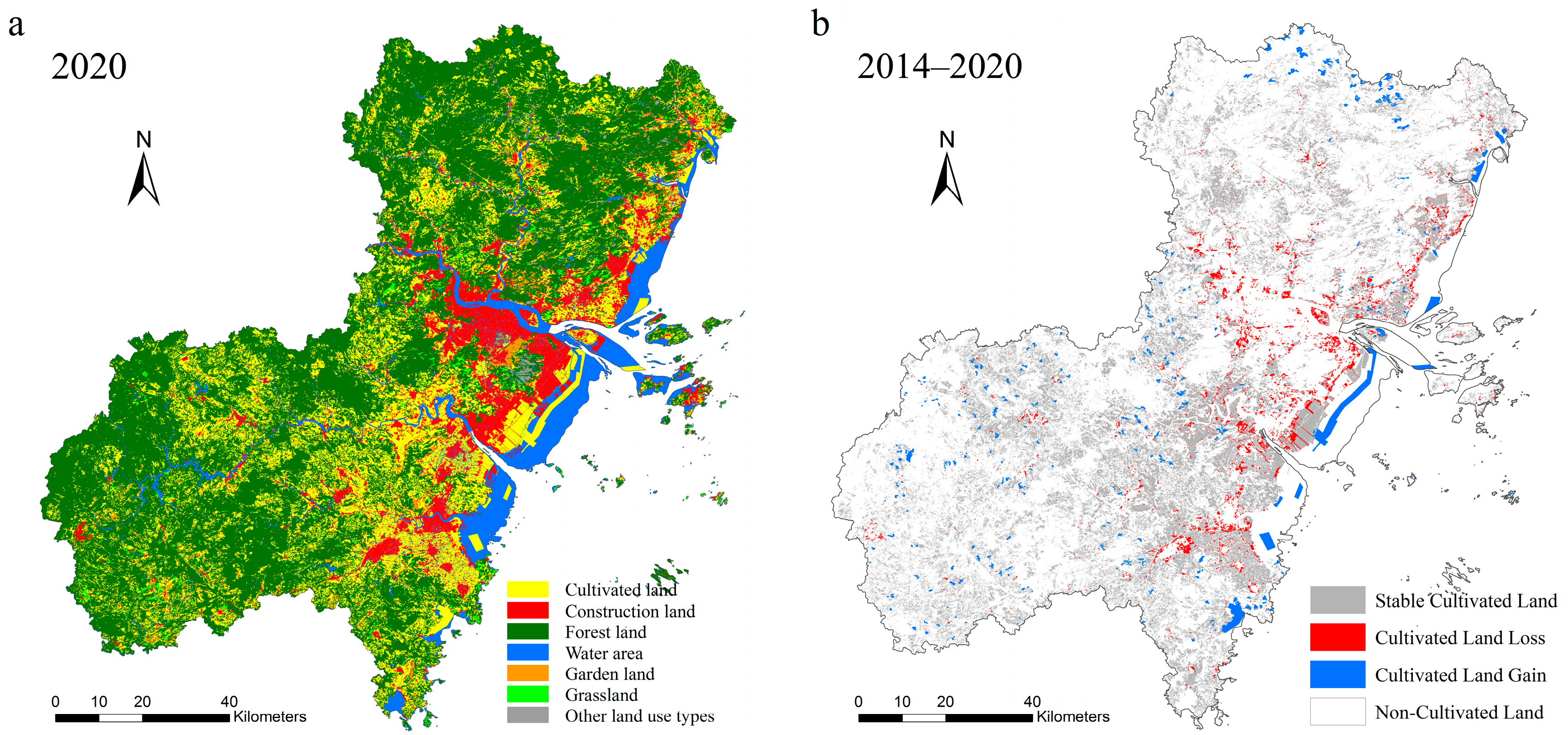
| Score (fi) | Soil Fertility (%) | Soil Texture | Organic Matter Content (%) | Topsoil Thickness (cm) | Irrigation Condition (d) | Elevation (m) |
|---|---|---|---|---|---|---|
| 100 | ≥80 | Loam | ≥3 | ≥20 | ≥70 | ≤10 |
| 95 | 18–20 | 10–50 | ||||
| 90 | Silt loam/clay loam | 2.5–3.0 | 15–18 | 50–150 | ||
| 85 | 70–80 | 50–70 | ||||
| 80 | Loamy clay/sandy loam | 2.0–2.5 | 150–300 | |||
| 75 | ||||||
| 70 | 60–70 | 1.5–2.0 | 10–15 | 300–500 | ||
| 65 | ||||||
| 60 | Clay | 1.0–1.5 | 30–50 | |||
| 55 | 50–60 | |||||
| 50 | <10 | 500–800 | ||||
| 45 | ||||||
| 40 | Sand | 0.5–1.0 | ||||
| 35 | 40–50 | |||||
| 30 | <30 | 800–1000 | ||||
| 20 | <0.5 | |||||
| 15 | <40 | |||||
| 10 | >1000 | |||||
| Weight (wi) | 0.25 | 0.1 | 0.2 | 0.1 | 0.2 | 0.15 |
| Period | Main Source | Area (ha) | Proportion (%) |
|---|---|---|---|
| 2005–2010 | Forest land | 6580.94 | 50.42 |
| Grassland | 3809.71 | 29.19 | |
| Garden land | 2173.79 | 16.65 | |
| Water area | 192.85 | 1.48 | |
| Bare land | 161.90 | 1.24 | |
| Construction land | 97.08 | 0.74 | |
| Coastal land | 36.18 | 0.28 | |
| Total | 13,052.45 | 100 | |
| 2010–2014 | Forest land | 3032.62 | 62.25 |
| Water area | 641.87 | 13.18 | |
| Coastal land | 612.43 | 12.57 | |
| Garden land | 390.30 | 8.01 | |
| Grassland | 184.00 | 3.78 | |
| Construction land | 9.54 | 0.20 | |
| Bare land | 0.67 | 0.01 | |
| Total | 4871.43 | 100 |
| Period | Changed Area (ha) | Relative Change Rate | |||||
|---|---|---|---|---|---|---|---|
| High | Medium | Low | High | Medium | Low | ||
| 2005–2010 | Loss | 7431.84 | 4634.00 | 104.00 | 3.17 | 0.52 | 0.12 |
| Gain | 787.74 | 10,989.70 | 1275.02 | 0.31 | 1.14 | 1.40 | |
| 2010–2014 | Loss | 2011.90 | 1802.84 | 135.35 | 2.75 | 0.61 | 0.49 |
| Gain | 169.38 | 2999.00 | 1703.06 | 0.19 | 0.83 | 4.96 | |
© 2017 by the authors; licensee MDPI, Basel, Switzerland. This article is an open access article distributed under the terms and conditions of the Creative Commons Attribution (CC-BY) license (http://creativecommons.org/licenses/by/4.0/).
Share and Cite
Lin, L.; Ye, Z.; Gan, M.; Shahtahmassebi, A.R.; Weston, M.; Deng, J.; Lu, S.; Wang, K. Quality Perspective on the Dynamic Balance of Cultivated Land in Wenzhou, China. Sustainability 2017, 9, 95. https://doi.org/10.3390/su9010095
Lin L, Ye Z, Gan M, Shahtahmassebi AR, Weston M, Deng J, Lu S, Wang K. Quality Perspective on the Dynamic Balance of Cultivated Land in Wenzhou, China. Sustainability. 2017; 9(1):95. https://doi.org/10.3390/su9010095
Chicago/Turabian StyleLin, Lin, Ziran Ye, Muye Gan, Amir Reza Shahtahmassebi, Melanie Weston, Jinsong Deng, Shenggao Lu, and Ke Wang. 2017. "Quality Perspective on the Dynamic Balance of Cultivated Land in Wenzhou, China" Sustainability 9, no. 1: 95. https://doi.org/10.3390/su9010095





